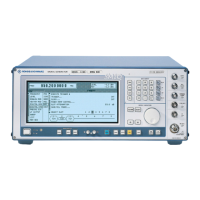SMIQ Digital Standard 3GPP W-CDMA (FDD)
1125.5555.03 E-92.223
Uplink
In the "DPCCH+DPDCH" mode, the signal consists of a DPCCH and one or several (max. 6) DPDCHs.
To derive the constellation of this signal, the constellation of a single channel (DPDCH or DPCCH) is
considered first. Its data are exclusively supplied to the I or Q path. The second path is not used
(second path is:
C
q
= 0).
with
S
i
= C
i
SC
i
– C
q
SC
q
'
S
q
= C
i
SC
q
' + C
q
SC
i
the following equation is obtained:
S
i
= C
i
SC
i
S
q
= C
i
SC
q
'
This corresponds to a QPSK constellation diagram. Compared to the DPCH constellation diagram, this
diagram is shifted and the constellation points only have half the amplitude:
Fig. 2-142 Constellation of a DPDCH/DPCCH channel
Note: A suitable modification of the PN sequences ("HPSK") in the uplink eliminates 50 % of all zero-
crossings, which, in contrast to the downlink, causes a deformation of the constellation ranges.
If DPCCH and DPDCH are combined, the constellation considerably depends on the ratio of the channel
powers. If the two powers are equal, a constellation as with the P-CCPCH will be obtained. The
following illustration shows the constellation with DPCCH power 0dB and DPDCH power –6 dB:
Fig. 2-143 Constellation of an uplink signal consisting of a DPDCH and a DPCCH

